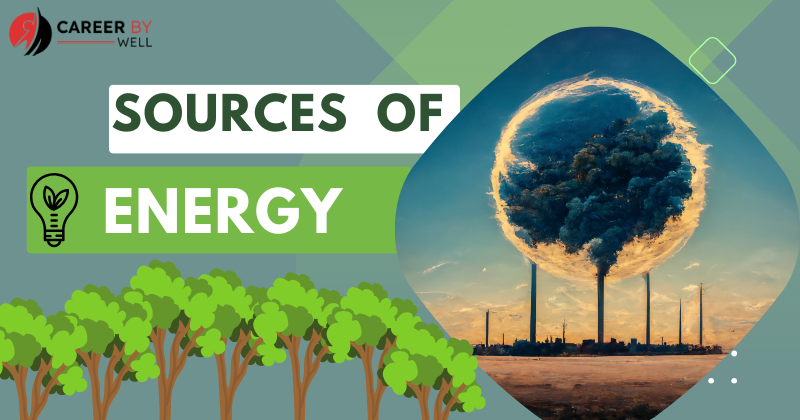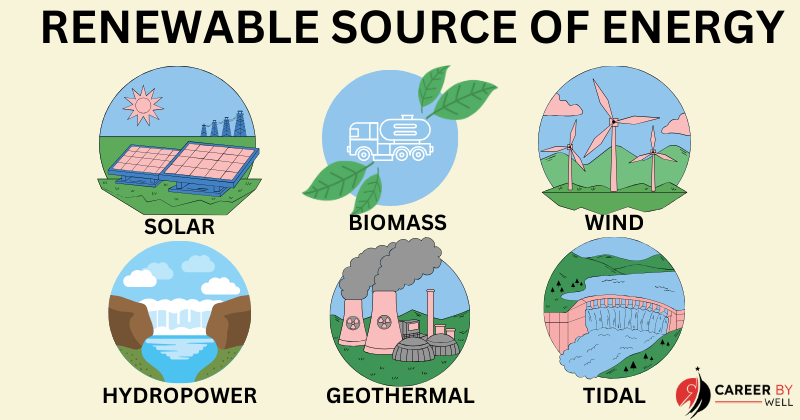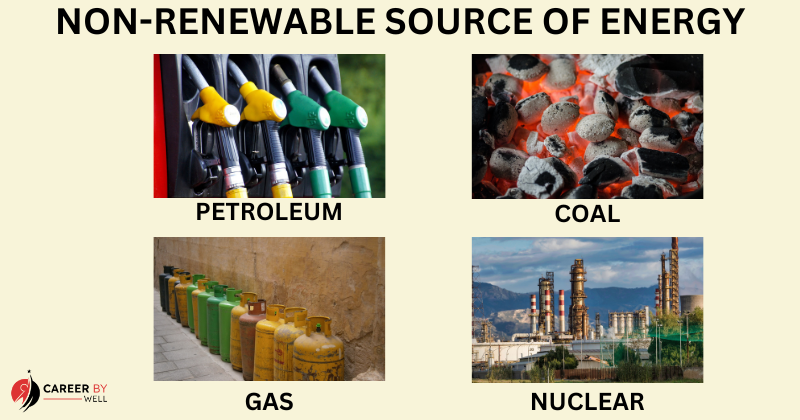Energy is what enables things to happen and transformations in the universe. Two kinds of sources of energy are Renewable and Non-Renewable.
Energy refers to the capacity or ability to do work or produce a change in a system. In essence, energy enables things to happen and transformations to occur in the universe. There are different sources of energy.
These sources of energy are broadly categorized into two main types:
- Renewable and
- Non-renewable.
Renewable Sources of Energy:
Renewable energy sources are natural resources that are replenished naturally and can be used to generate power sustainably. These energy sources are also known as non-conventional energy sources.
These energy sources are environmentally friendly because they produce little to no greenhouse gas emissions.
Solar Energy:
The sun is the ultimate source of energy. Solar energy is a renewable and sustainable power source from sun radiation. It’s one of the cleanest and most abundant energy sources available on Earth, with no greenhouse gas emissions during electricity generation.
Solar energy is harnessed through various technologies, primarily photovoltaic (PV) solar cells and solar thermal systems.
Solar panels capture sunlight and convert it into electricity. This process, called photovoltaics, relies on the photoelectric effect.
Solar energy is abundant, especially in regions with ample sunlight, and it can be harnessed through photovoltaic panels on rooftops or solar farms.
Wind Energy:
Wind energy is a renewable and sustainable power source generated from the wind’s kinetic energy. It is one of the fastest-growing sources of electricity worldwide, with turbines harnessing the power of moving air to produce clean electricity.
Usually, Wind energy is captured using wind turbines, which are large structures equipped with rotor blades. These blades spin when the wind blows, driving a generator to produce electricity.
Wind turbines harness the kinetic energy of the wind to generate electricity.
Wind energy is clean because it produces no direct emissions of greenhouse gases or air pollutants during electricity generation. It helps reduce carbon emissions and combat climate change.
Hydropower:
Hydropower, or hydroelectric power, generates electricity by harnessing the energy of flowing water, typically in dams and waterfalls. It’s one of the oldest and most widely used renewable energy sources.
Hydropower has been harnessed for centuries, and modern technological advancements continue to improve its efficiency and reduce its environmental impact. It remains a crucial component of the transition to clean and sustainable energy sources.
Typically, Hydropower is generated by capturing the kinetic energy of moving water and converting it into electrical energy. This is generally done using a system of dams, reservoirs, and turbines.
Types of Hydropower:
Usually, there are two primary types of hydropower systems:
- Run-of-River Hydropower: The river’s water flow is not significantly altered. A portion of the river’s flow is diverted through turbines to generate electricity, allowing minimal disruption of the natural watercourse.
- Reservoir Hydropower: Systems involve the construction of large dams to create artificial lakes or reservoirs. Moreover, Water can be released from these reservoirs as needed to generate electricity, offering greater control over power generation.
Biomass Energy:
Biomass energy is derived from organic materials such as wood, agricultural residues, and waste. It can be burned for heat or converted into biofuels like ethanol.
Biomass energy provides a valuable pathway to reduce greenhouse gas emissions, especially when it replaces fossil fuels. It is a versatile and flexible renewable energy source that can contribute to a more sustainable and diversified energy mix.
However, its environmental and land-use impacts require careful management and consideration.
Biomass can be converted into biofuel, including bioethanol, biodiesel, and biogas. Bioethanol is typically made from crops like corn and sugarcane, while biodiesel is produced from vegetable oils and animal fats.
However, burning biomass for energy is the most straightforward way to use it.
Biomass can be burned directly for heat or converted into electricity through combustion in power plants. Biomass boilers and stoves are also used for space heating and hot water production.
Biogas is produced through the anaerobic digestion of organic materials in an oxygen-free environment. Further, it consists mainly of methane and carbon dioxide and can be used for heating, electricity generation, or as a vehicle fuel.
These processes heat biomass without oxygen to produce biochar, bio-oil, and syngas. Biochar can be used as a soil amendment, while bio-oil and syngas can be used for heat, electricity, and liquid fuel production.
Additionally, biomass is considered a carbon-neutral energy source because the carbon dioxide released during combustion is roughly equivalent to the carbon dioxide absorbed by the plants during their growth.
However, this assumes sustainable harvesting and management practices.
Usually, Biomass energy can have environmental benefits when it involves waste materials or sustainable forestry and agriculture practices. However, large-scale biomass production can lead to deforestation, habitat loss, and competition with food crops.
Geothermal Energy:
Geothermal power plants use heat from the Earth’s interior to generate electricity. It’s a reliable and sustainable energy source, often used in regions with significant geothermal activity.
Geothermal energy taps into the heat naturally generated within the Earth’s core due to the decay of radioactive isotopes and the planet’s formation. This heat continually flows from the Earth’s interior toward the surface.
Underground reservoirs of hot water or steam, known as geothermal reservoirs or geothermal fields, store the Earth’s heat. These reservoirs are typically found in regions with tectonic plate boundaries, such as geysers and hot springs.
Generally, Geothermal power plants capture the heat from these reservoirs and convert it into electricity. The most common geothermal power plants are dry steam, flash steam, and binary cycle plants, which use different methods to generate electricity.
Usually, Geothermal heat pump systems, also known as ground-source heat pumps, use the relatively stable temperature of the Earth just below the surface to provide efficient heating and cooling for buildings.
These systems can significantly reduce energy consumption for heating and cooling.
Geothermal energy is a reliable and constant power source since the heat from the Earth’s interior is nearly inexhaustible.
Unlike some renewable sources, it is not dependent on weather conditions or time of day.
Despite its advantages, geothermal energy faces challenges, such as the need for drilling deep wells, potential resource depletion in localized areas, and the risk of induced seismicity (earthquakes) in some geothermal regions.
Tidal Energy:
Tidal power captures the energy generated by the moon’s and the sun’s gravitational pull on the Earth’s oceans. It’s a predictable and renewable source of energy.
Tidal energy holds promise as a clean and renewable energy source with the potential to contribute to a diversified energy mix.
While it faces site selection, technological development, and cost challenges, ongoing research and investment aim to harness its full potential. The difference in water levels between high and low tides is known as the tidal range.
Areas with significant tidal ranges are prime locations for tidal energy generation.
Tides rise and fall, creating strong tidal currents in coastal areas and estuaries. These currents move large volumes of water, carrying kinetic energy.
Tidal energy is generated using underwater turbines, similar in concept to wind turbines. Further, these turbines are placed on the seabed or anchored to the ocean floor to capture the kinetic energy of the moving water.
Non-renewable Sources of Energy:
Non-renewable energy sources are natural resources that have finite reserves and cannot be replenished on human timescales. These energy sources, including fossil fuels and nuclear materials, are typically extracted from the Earth.
These energy sources are also known as conventional sources of energy.
Fossil Fuels:
Indeed, Fossil fuels have been the dominant sources of energy for the past century, powering industries, transportation, and households. Fossil fuels are non-renewable energy sources formed from the remains of ancient plants and animals that lived millions of years ago.
These organic materials, primarily composed of carbon and hydrogen, have undergone geological processes like heat and pressure over time, transforming into fossil fuels. There are three main types of fossil fuels:
- Coal
- Oil (Petroleum)
- Natural Gas
Coal:
Coal is a black or brownish-black sedimentary rock composed primarily of carbon and other elements like hydrogen, sulfur, oxygen, and nitrogen. It’s one of the oldest and most widely used fossil fuels.
Coal can be found in several forms, such as anthracite, bituminous, and lignite, with varying energy content and quality. It has historically been used for electricity generation, heating, and industrial processes.
Oil (Petroleum):
Petroleum, commonly referred to as oil, is a liquid fossil fuel. It’s a complex mixture of hydrocarbons and other organic compounds.
Crude oil is extracted from underground reservoirs and refined into various products like gasoline, diesel fuel, jet fuel, and petrochemical feedstocks.
Indeed, Oil is a significant energy source for transportation used in multiple industrial processes.
Natural Gas
Natural gas is a gaseous fossil fuel primarily composed of methane (CH4). It can be found deep underground or associated with oil deposits.
Further, Natural gas is used for heating, electricity generation, and as a fuel for vehicles. It’s considered one of the cleaner-burning fossil fuels because it produces fewer emissions than coal and oil.
Besides, efforts are underway worldwide to reduce the dependence on fossil fuels, increase energy efficiency, and accelerate the transition to cleaner energy sources as part of a broader strategy for a more sustainable and environmentally responsible energy future.
Nuclear Energy:
Nuclear energy has been a significant source of electricity in many countries and plays a role in the global energy mix.
Its unique characteristics, including low greenhouse gas emissions and high energy density, make it a subject of ongoing debate regarding its role in transitioning to a more sustainable, low-carbon energy future.
Nuclear energy is non-renewable energy derived from nuclear reactions, specifically atomic fission.
It is harnessed by splitting the nuclei of certain heavy atoms, such as uranium-235 (U-235) or plutonium-239 (Pu-239), in a controlled process to release a significant amount of energy.
Nuclear energy is produced through nuclear fission, a process in which the nucleus of an atom is split into two or more smaller nuclei, along with the release of a large amount of energy.
This process is initiated and controlled in nuclear reactors.
Nuclear reactors are facilities designed to control and utilize the energy released during nuclear fission.
They consist of fuel rods, control rods, a coolant system, and other components. The fuel rods contain fissile material, and the control rods regulate the fission process by absorbing neutrons.
However, Nuclear accidents, although rare, can have catastrophic consequences. Significant accidents like Chornobyl (1986) and Fukushima (2011) highlighted the importance of stringent safety measures and emergency preparedness in the nuclear industry.
Peat:
Usually, Peat forms in waterlogged environments, such as peat bogs and swamps, where dead plant material accumulates and decomposes slowly due to the anaerobic (low-oxygen) conditions. Over time, this accumulation of organic matter transforms into peat.
Peat has an energy content that can be used for heating and electricity generation. It can be burned directly as a fuel in peat-fired power plants, and it has been historically used for domestic heating in some regions.
While peat can be burned to release energy, its use as a fuel source has significant environmental drawbacks.
When peat is drained and harvested for fuel, it disrupts fragile wetland ecosystems and releases stored carbon dioxide (CO2) and methane (CH4) into the atmosphere. This release of greenhouse gases exacerbates climate change.
Due to its environmental impacts, there is a growing trend to reduce or phase out peat as an energy source. Many countries are transitioning to cleaner and more sustainable sources of energy, such as renewables (solar, wind, hydro) and natural gas.
Final Thoughts
In short, choosing energy sources can have significant economic, environmental, and geopolitical implications.
Concerns about climate change, air and water pollution, and the depletion of finite fossil fuel reserves drive the shift towards renewable and cleaner energy sources.
The transition to renewable energy sources is a global effort to reduce greenhouse gas emissions, combat climate change, and promote energy security.
It involves integrating renewables into electricity grids, electrifying transportation, and improving energy efficiency.
Today, renewable energy sources, including wind, solar, Hydropower, and biomass, are gaining prominence as the world seeks cleaner and more sustainable energy options.
Many countries are investing in renewable energy infrastructure and transitioning from fossil fuels.



